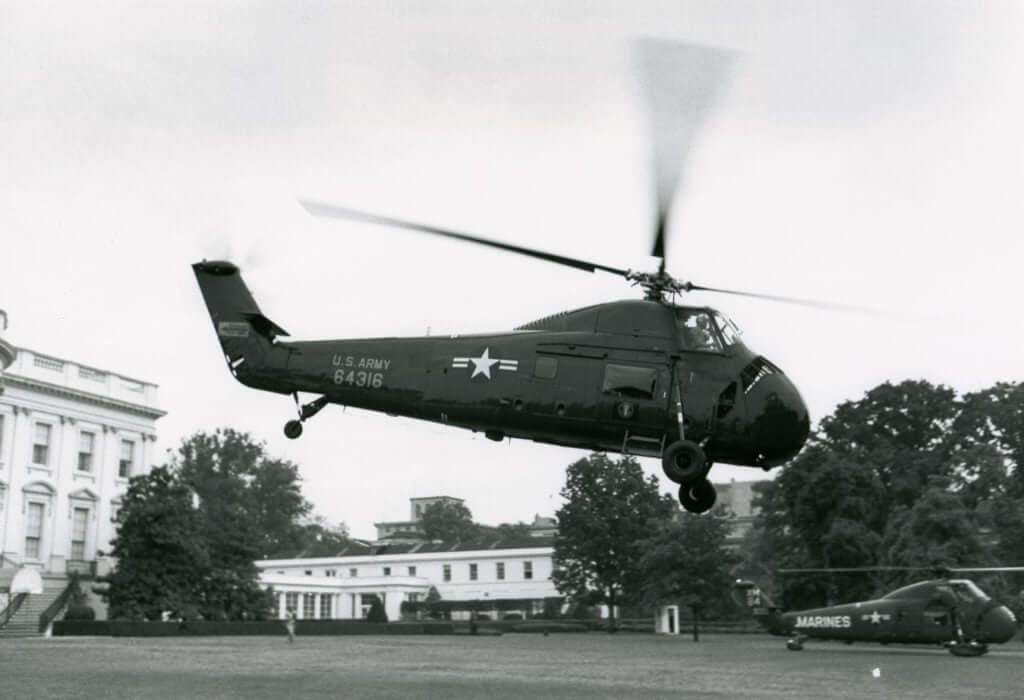In 1957, while President Dwight Eisenhower was on vacation in Newport, Rhode Island, he was recalled urgently to Washington.
Instead of driving two hours around Narragansett Bay, which separated him from the airport where Air Force One was parked, or enduring a rough 40-minute ferry ride, Eisenhower opted to fly in a U.S. Marine Corps Sikorsky UH-34 Choctaw. The 10-minute flight to his plane saw Eisenhower become the first president to use a rotorcraft for official duty.

The flight was not Eisenhower’s first, but he is said to have preferred the H-34 over a competing company’s plastic bubble cockpit, according to Sikorsky president Dan Schultz, who spoke at an Oct. 3 ceremony at the National Museum of the Marine Corps in Quantico, Virginia. The occasion was to mark the unveiling of the White House Historical Association’s annual Christmas ornament, which this year is shaped like one of Eisenhower’s H-34 presidential helicopters.
All the following 12 White House residents have flown in helicopters since Ike popularized them. Eisenhower wrote a famous letter to Sikorsky founder Igor Sikorsky on the occasion of the 20th anniversary of the first flight of a helicopter in the U.S.
“As the inventor of this aircraft, you are justifiably proud to have success in rapid development,” Eisenhower wrote. “You are perhaps familiar with my use of helicopters in recent years. For my purposes they are invaluable. I have also been repeatedly impressed by stories of rescue missions in which their unique capabilities have enabled them to perform with particular effectiveness, saving lives that would otherwise have been lost.”
The 1957 flight was the unofficial beginning of the presidential worldwide vertical lift mission that still exists today. Marine Helicopter Squadron One, or HMX-1, had existed as an experimental aviation unit base in Quantico for about a decade by 1957, according to retired Marine Corps Col. Kevin Wild, a former HMX-1 commander.
“This is the only no-fail mission the Marine Corps has,” Wild said.
The unit to this day flies the president around Washington, D.C., to and from Camp David and back and forth to Andrews Air Force Base in Maryland, where Air Force One is stationed.
Sikorsky has provided all of the HMX-1 helicopters, designated “Marine One” when the president is aboard, beginning with the H-34. Initially, the mission of flying the president was shared 50/50 between an Army and a Marine Corps detachment, each with its own H-34s.
The Army eventually withdrew from the mission, leaving the Marine Corps to take over rotorcraft flights for the president. In 1963, the H-34 aircraft were replaced by the VH-3A Sea King in 1963 and the VH-3D in 1974. Sikorsky will again replace the presidential helicopter fleet with the VH-92, based on the commercial S-92, now in development.

“We’re looking forward to the next 62 years,” Schutlz said. The S-92 “is the safest, most reliable helicopter in the entire world today. . . . It is an incredible honor and also a duty for us to bring this helicopter into the presidential fleet.”
Several VH-92s are in flight test at Naval Station Patuxent River in Maryland, south of Washington, D.C. They are not authorized to carry the president yet, but should eventually replace the current fleet of VH-3D “Marine One” Sea Kings and VH-60N White Hawks, both made by Sikorsky.
The company is cleared to build six VH-92s under a $542 million low-rate production Navy contract awarded in May. Those aircraft will be delivered to the Marine Corps between 2021 and 2023. Marine Corps plans call for a fleet of 23 VH-92s, including 17 production helicopters — four for training and two test aircraft.










Great report, thank you! I’m looking back at a total of 55 years in the helicopter business, initially in the German Army as a co-pilot on the CH-53G. Later I worked for twelve years with Sikorsky Aircraft as Director of European Operations, followed working with Erickson using the Aircrane especially for power line construction in Europe. A very satisfying aviation life.
The US Army shared the flights with the Marine Corp (Marine One) until 1976. I have several friends that were part of the Army flight detachment.
Army One is the callsign of any United States Army aircraft carrying the President of the United States. From 1957 until 1976, this was usually an Army helicopter transporting the President. Prior to 1976, responsibility for helicopter transportation of the President was divided between the Army and the U.S. Marine Corps until the Marine Corps was given the sole responsibility of transporting the President by helicopter.
During its presidential service, the helicopter was known either as Marine One or Army One, depending on whether Marine or Army pilots were operating the craft.[3] The helicopter, with seats for sixteen, has a seat reserved for the president and the first lady, and single, smaller seats for the two Secret Service agents who always flew with the presidential party.[4]
Wherever the helicopter carrying a US President flies, it is met on the ground by at least one soldier in full dress uniform.[5] An Army aircraft carrying the Vice President is designated Army Two.